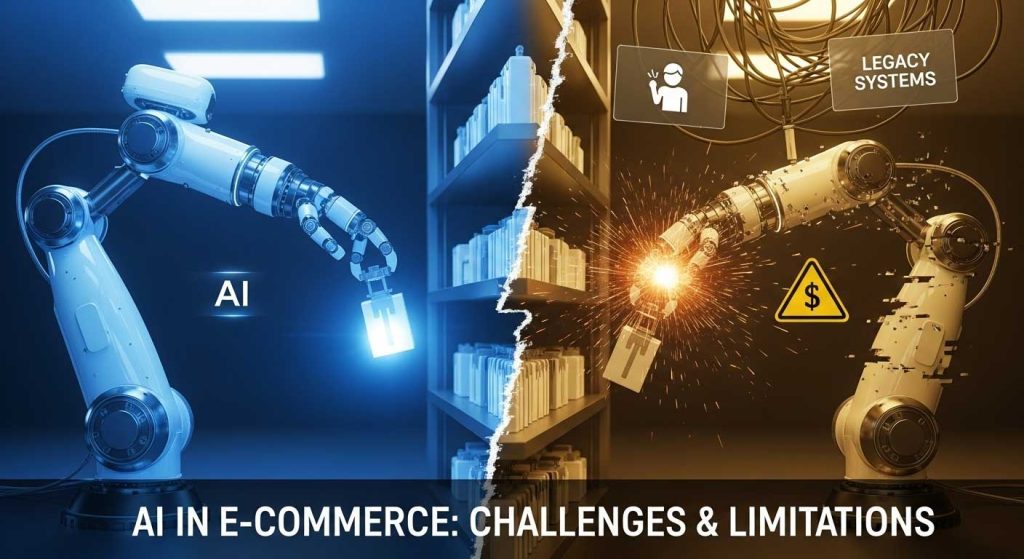Artificial intelligence is consistently hailed as the undisputed future of e-commerce. The narrative is powerful and persuasive, promising a world of flawless personalization, fully automated 24/7 customer support, and uncanny predictive analytics that can anticipate a customer’s every need. For many businesses across the USA, however, the day-to-day reality of implementing AI is far more complex and challenging.
Table of Contents
The promised utopia is often riddled with frustrating technical failures, thorny ethical dilemmas, and staggering, often hidden, costs. These are the real challenges of AI in e-commerce, the practical hurdles that separate the hype from the actual return on investment.

This article will move beyond the headlines to provide a realistic, in-depth look at the top challenges and limitations of AI in e-commerce today. By examining real-world e-commerce AI failures, from the technical meltdowns of peak season to the slow erosion of customer trust, we will provide a clear and actionable framework for understanding these critical hurdles. This is an essential guide for any business looking to navigate the realities of AI adoption.

Technical & Performance Challenges: When the Code Meets the Customer
Before an AI can revolutionize a business, it has to work—reliably, quickly, and at scale. For many e-commerce companies, this is where the first and most significant challenges of AI in e-commerce appear. The technical foundation must be solid, or the entire strategy will crumble under the weight of real-world customer traffic.

The Engine Sputters: Why E-Commerce AI Fails Under Pressure
Challenge #1: The “Garbage In, Garbage Out” Problem of Data Quality
The single most important technical factor for the success of any AI system is the quality of its data. Data quality for AI is not just a buzzword; it is the absolute bedrock of its functionality.
AI models learn from the data they are fed. If that data is flawed, the AI’s conclusions and actions will be equally flawed. Common data quality issues that plague e-commerce businesses include:
- Incomplete Data: Customer profiles with missing fields or products without proper attributes.
- Inaccurate Data: Outdated customer addresses, incorrectly tagged product categories, or flawed sales records.
- Siloed Data: Customer information that is trapped in separate, non-integrated systems, such as a CRM, an e-commerce platform, and a marketing automation tool.
When an AI is trained on this “dirty” data, the results are predictably poor. It leads to irrelevant product recommendations, flawed customer segmentation, and marketing campaigns that target the wrong people. This is a fundamental limitation of AI in e-commerce: the AI is only as good as the data it learns from.
Challenge #2: Peak Season Meltdowns and AI Scalability Issues
Every year, U.S. e-commerce sites brace for the massive traffic surges of Black Friday and Cyber Monday. It is during these high-stakes events that many AI scalability issues come to a head.
Personalization engines and AI chatbots must process millions of data points in real time to function correctly. The sudden, exponential increase in user activity can overwhelm the server infrastructure and data processing pipelines. When this happens, customers who have come to expect a tailored experience are instead met with generic, non-personalized content, slow-loading pages, or chatbots that crash entirely. These e-commerce AI failures occur at the worst possible moment, leading directly to lost sales and frustrated customers.
Challenge #3: The Frustration of AI Chatbot Limitations
AI-powered chatbots are often promoted as a way to automate customer service and cut costs. While they are incredibly effective at handling simple, high-volume, repetitive questions (the classic “Where is my order?”), their limitations become glaringly obvious when faced with more complex issues.
The core AI chatbot limitations include:
- Lack of True Contextual Understanding: Chatbots struggle to grasp sarcasm, ambiguity, or the true intent behind a frustrated customer’s message.
- Limited Scope and “Edge Cases”: They are trained on a specific set of data and are often incapable of handling unique problems they haven’t encountered before.
- Inability to Show Empathy: A chatbot cannot genuinely connect with an angry or upset customer. Its formulaic, robotic responses can feel dismissive and often escalate a negative situation. This is a critical consideration when balancing automation and a human touch.
Challenge #4: The Millisecond Hurdle: Real-Time Personalization Latency
One of the biggest AI personalization challenges is the technical requirement of speed. True real-time personalization involves collecting a data point (like a customer clicking on a product), sending that data to the AI model, receiving a prediction, and then altering the webpage for that user—all in the blink of an eye.
This process, known as latency, must be completed in milliseconds to be effective. Achieving this requires incredibly powerful and expensive computing infrastructure. For many retailers, especially during high-traffic periods, the process can be too slow, resulting in a delayed personalization attempt (like showing a recommendation for a product the user has already clicked away from) or a complete failure to personalize the experience at all.
Ethical & Legal Challenges: Navigating the Minefield of Data and Bias
Beyond the technical glitches, some of the most profound challenges of AI in e-commerce lie in the ethical and legal gray areas. The very processes that make AI effective—collecting vast amounts of data and making automated decisions—are fraught with risks related to bias, privacy, and fairness.

The Fine Line Between Personalization and Privacy Invasion
Challenge #5: Algorithmic Bias in E-Commerce: The Unfair Advantage
Algorithmic bias in e-commerce is one of the most serious and subtle limitations of AI. Because AI models learn from historical data, they can easily inherit and even amplify the biases present in that data.
- Instance: Imagine an AI recommendation engine trained on years of sales data. If that data shows that a certain high-margin product was historically purchased by customers in a specific demographic, the AI might learn to disproportionately promote that product only to that group. This creates a self-fulfilling prophecy, alienating other potential customer segments and leading to unfair outcomes.
- Instance: This bias also appears in voice search. Assistants like Amazon’s Alexa don’t always provide the most relevant product results. Their algorithms can prioritize certain paid placements or default listings, which impacts fairness and erodes AI and customer trust.

Challenge #6: The “Creepy” Factor and Customer Privacy
The main privacy concern with AI is the sheer volume and depth of data collected to build customer profiles. This often goes far beyond simple purchase history. AI can infer sensitive information like income level, lifestyle habits, and major life events based on browsing behavior.
According to industry surveys, this is not a niche concern. Around 60% of consumers report feeling concerned about how companies use their personal data for AI-driven personalization. When this personalization crosses the line from helpful to intrusive (for example, showing an ad for a product a user only spoke about aloud), it creates a “creepy” feeling of being surveilled, which can cause customers to lose trust and actively avoid a brand.
Challenge #7: The Complexity of CCPA E-Commerce Compliance
In the United States, the legal landscape around data privacy is rapidly evolving. The California Consumer Privacy Act (CCPA) is a landmark piece of legislation that grants consumers rights over their data, including the right to know what is being collected and to opt out of their data being shared.
This presents a major challenge for CCPA e-commerce compliance. The “black-box” nature of many advanced AI models—where even the creators can’t fully explain the reasoning behind a specific decision—makes it incredibly difficult for businesses to be fully transparent with their customers about how their data is being used, complicating legal compliance.
Challenge #8: The Murky Waters of Dynamic Pricing Ethics
One of the most controversial limitations of AI in e-commerce is dynamic pricing. This is when an AI algorithm adjusts the price of a product for a specific user based on their data profile and perceived willingness to pay. While this is legal in many contexts, it raises serious ethical questions. If an AI charges a higher price to a customer because their data suggests they are in a wealthier zip code or are in urgent need of a product, is that fair competition or is it price gouging? This practice can severely damage AI and customer trust if customers feel they are being treated unfairly.
At a Glance: Key Challenges of AI in E-Commerce
| Challenge Category | Specific Challenge | Real-World Instance / Example | Impact on the E-Commerce Business |
| Technical & Performance | AI Scalability Issues | Personalization engines and chatbots crashing or slowing down during Black Friday sales events in the U.S. | Lost Sales & Customer Frustration: Failure to handle peak traffic leads directly to cart abandonment and a poor brand experience. |
| Customer Experience & Trust | False Positives & Lack of Nuance | The Walmart AI theft detection system misidentifying normal shopping behavior as suspicious, leading to false accusations. | Erosion of Customer Trust: False accusations and frustrating, non-empathetic chatbot interactions can permanently damage customer loyalty. |
| Ethical & Bias | Algorithmic Bias in E-Commerce | A recommendation engine trained on biased data disproportionately promotes products to one demographic, ignoring other potential customers. | Alienated Customers & Missed Revenue: Unfairly targeting or ignoring customer segments leads to a poor experience and lost sales opportunities. |
| Legal & Compliance | Data Privacy & Transparency | A company using a “black-box” AI model struggles to explain its data usage to comply with CCPA e-commerce compliance requests. | Legal Fines & Reputational Damage: Failure to comply with U.S. privacy laws can result in massive penalties and a public loss of trust. |
| Business & Financial | High Cost & Talent Shortage | A medium-sized U.S. retailer spends over $100,000 on an AI project but struggles to hire a qualified AI engineer to maintain it. | Barrier to Entry & Unsustainable Projects: The high cost of AI for small business and the scarcity of talent limit competition and can lead to failed implementations. |
| Integration | Legacy System Integration AI | An established retailer cannot connect its new AI personalization tool to its old, siloed inventory system, leading to recommendations for out-of-stock items. | Operational Inefficiency & Poor CX: Incomplete or broken automation creates a disjointed customer experience and negates the potential efficiency gains. |
Business & Cost-Related Challenges: The High Price of Intelligence
Beyond the code and the ethics, there are hard financial and operational realities that present significant challenges of AI in e-commerce. For many businesses, especially those outside of the tech giants, these practical hurdles are the most difficult to overcome.

The Financial Barrier: The Real Cost of AI for Small Business
While simple AI-powered plugins for platforms like Shopify might be affordable, implementing a truly impactful, custom AI solution is a major financial undertaking.
- Initial Costs: The upfront cost for developing and integrating a custom AI system for personalization or fraud detection can easily range from $10,000 to well over $100,000.
- Ongoing Costs: This is where many businesses get into trouble. The expenses don’t stop after launch. There are significant ongoing costs for cloud data storage, processing power, and regular model maintenance.
This high cost of AI for small business creates a significant competitive disadvantage, making it one of the toughest limitations of AI in e-commerce for the vast majority of retailers.
Challenge #9: The Scarcity of Skilled AI Talent
Even if a business can afford the software, they often struggle to find the people needed to run it. There is a well-documented AI talent shortage in the United States. The most qualified AI engineers and data scientists are often recruited by big tech companies with enormous budgets, leaving other businesses with a very small and very expensive talent pool to choose from.
Challenge #10: The “Plumbing” Problem: Legacy System Integration AI
This is one of the most common and frustrating e-commerce AI failures for established retailers. Many of these businesses are built on older, legacy systems for their inventory management, customer relationship management (CRM), and payment processing.

These older systems were not designed to communicate with modern AI tools. They are often siloed, meaning the data is trapped and cannot be easily accessed. This legacy system integration AI challenge is a massive blocker. An AI personalization engine is useless if it can’t get real-time data from the inventory system, leading to the classic failure of recommending an out-of-stock product to a customer.
Challenge #11: The Myth of Full Automation
One of the biggest selling points of AI is the promise of automation, particularly in customer support. However, the idea that AI can completely replace human agents is a dangerous myth and one of the biggest AI chatbot limitations.

As demonstrated by countless frustrating customer experiences, AI cannot handle complex, emotional, or nuanced problems. Over-automating customer service is a recipe for brand damage. The most effective and sustainable strategy is a human-in-the-loop AI model, where the AI handles the simple, first-tier questions, with a clear and easy path for the customer to escalate to a skilled human agent for real problem-solving.
Conclusion: Balancing Automation and Humanity for a Smarter Future
The journey to integrate artificial intelligence into e-commerce is not the smooth, effortless path that the hype often suggests. The real path is filled with significant challenges of AI in e-commerce, from technical hurdles like data quality and scalability to the complex ethical landscapes of bias and privacy. The high costs and integration difficulties present formidable barriers, and the constant need to maintain AI and customer trust requires a delicate touch.

The key takeaway for any business in the U.S. looking to leverage this powerful technology is that AI is not a “magic bullet.” Its successful implementation is not just about buying the right software; it’s about having a realistic understanding of its limitations of AI in e-commerce and making a strategic commitment to balancing automation and a human touch.
The most successful e-commerce brands of the future will not be the ones that simply automate everything. They will be the ones that use AI to handle the scale and complexity of data, while empowering their human employees to handle the nuance, creativity, and empathy that builds lasting customer relationships. Approaching AI with a clear-eyed, strategic mindset—and a focus on solving these challenges—is the true path to building a sustainable and competitive advantage.
Frequently Asked Questions (FAQs)
1. What is the single biggest technical challenge for AI in e-commerce?
The single biggest technical challenge is data quality. Without clean, accurate, and unified data, no AI model can produce reliable or effective results. The principle of “garbage in, garbage out” is the most fundamental limitation.
2. How can a small business avoid the high costs of AI?
Instead of attempting a large, custom implementation, small businesses should start with affordable, task-specific AI tools. This could mean using an AI-powered email marketing platform, a smart SEO tool, or a product recommendation plugin for their e-commerce store.
3. Is algorithmic bias in AI illegal?
It can be. If algorithmic bias in e-commerce leads to discriminatory practices that violate fair housing or credit laws (for example, by showing different prices or products based on protected characteristics), it can have serious legal consequences.
4. Why can’t my chatbot understand my simple question?
This is a common frustration and a key AI chatbot limitation. It often happens because the chatbot lacks true contextual understanding, your question is an “edge case” it wasn’t trained on, or it can’t parse ambiguous language.
5. How can I tell if a brand’s personalization is becoming too intrusive?
The line is crossed when the personalization makes you feel watched or uncomfortable. A classic sign is seeing an ad for a product that you only mentioned in a private conversation or a text message, indicating that your data is being used in ways you did not expect or consent to.
6. Will AI ever be able to completely replace human customer service agents?
It is highly unlikely. While AI will continue to automate more routine tasks, it cannot replicate the genuine empathy, complex problem-solving abilities, and critical thinking skills of a human agent, which are essential for resolving high-stakes customer issues.
7. What is a “human-in-the-loop” system, and why is it important?
A human-in-the-loop AI system is a model where the AI handles the bulk of the work but is designed to recognize when it is uncertain or dealing with a complex issue and then automatically flags it for a human to review and handle. It’s the essential strategy for balancing automation and a human touch.
8. My company has an old inventory system. Can we still use AI?
Yes, but you will face significant legacy system integration AI challenges. The most effective approach is often to first invest in a “data warehousing” solution that can pull data from your old system and your new tools into one centralized, clean location for the AI to access.
9. How can we prevent our AI from making biased recommendations?
Preventing bias requires a conscious effort. This includes regularly auditing your AI’s training data for historical biases, using diverse and representative datasets, and having human teams regularly review the AI’s outputs to check for unfair patterns.
10. Do customers in the U.S. generally trust AI in e-commerce?
Trust is mixed and conditional. Customers appreciate helpful, time-saving AI (like accurate recommendations), but they are increasingly wary of how their data is being used. Trust is very fragile and can be instantly broken by frustrating chatbot experiences or intrusive personalization.









